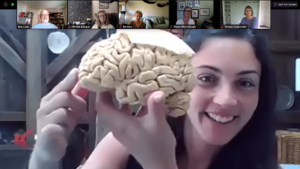
by Nina Silverberg, Ph.D., director of the NIA Alzheimer’s Disease Research Centers program
Imagine being able to look inside the brain of a person with Alzheimer’s disease and see the changes that are interfering with that person’s thinking, memory, and other important brain functions. Scientists working in the field of neuropathology are doing just that.
Using a variety of methods, neuropathologists view patterns of abnormal protein clusters and cellular damage in brain tissue under a microscope and through computer-driven imaging. They use that information to characterize the changes that occur in the brain with particular diseases or conditions.
For example, in 1906, the psychiatrist and neuropathologist Alois Alzheimer first identified the abnormal buildup of protein fragments — amyloid plaques and neurofibrillary (tau) tangles — in the brain tissue of a woman who had died from a previously unknown disease that caused a decline in her ability to think, remember, and speak. This illness was later named Alzheimer’s disease, which is the most common form of dementia. Neuropathologists today continue to actively work on identifying the changes that can be seen in the brain after death and connecting those to symptoms and biological processes observed during life.
Neuropathology is the study of diseases of the brain, spinal cord, and nerves through analyzing tissues removed during autopsy or biopsy. This analysis is central to research on Alzheimer’s disease and other neurodegenerative diseases. Neuropathology researchers look for signs of disease and disease progression and can identify whether changes in the brain are related to the protein accumulations seen in Alzheimer’s disease, like in the image below, or to other underlying causes of dementia.
Long before the symptoms of memory loss appear, many molecular and cellular changes take place in the brain of a person with Alzheimer’s. Neuropathology research has been essential in helping to identify these biological changes, called biomarkers, and revolutionizing the methods scientists and doctors can use to diagnose and treat these diseases. For example, 20 years ago, the only sure way to know whether a person had Alzheimer’s was through autopsy. Since then, researchers have developed and tested methods to “see” evidence of protein fragments associated with Alzheimer’s on brain scans, in cerebrospinal fluid, and even in blood while people are still alive. Being able to diagnose Alzheimer’s in the early stages is helping researchers to test new treatments that may slow or stop progression of the disease.
Still, as far as neuropathology has evolved, there is much to learn. For example, not everyone with amyloid plaques and tau tangles — the hallmark signs of Alzheimer’s — will eventually develop this disease. In addition, many people who are diagnosed with Alzheimer’s dementia have evidence of other pathologies in their brain, either instead of or in addition to those associated with Alzheimer’s. What factors influence the development of these different dementia-related pathologies? How can science help to better identify the underlying causes of dementia symptoms, so that we can better diagnose, treat, and prevent dementia? What causes the variability in the rate, severity, and type of cognitive decline among people with Alzheimer’s?
To address these questions and other complexities of dementia diseases, NIA-supported researchers are using the power of neuropathology in both traditional and innovative ways. For example, large studies of healthy adults over many years, new technologies to understand changes in individual brain cells, and collaboration among scientists with different expertise is equipping researchers with the information needed to map the connections between brain changes and risk factors that lead to dementia.
Neuropathology led to the discovery of Alzheimer’s disease and continues to provide invaluable insights today. NIA supports a wide range of neuropathological research to identify how and why these brain changes happen and to help develop tailored treatment and prevention strategies across diverse populations.
